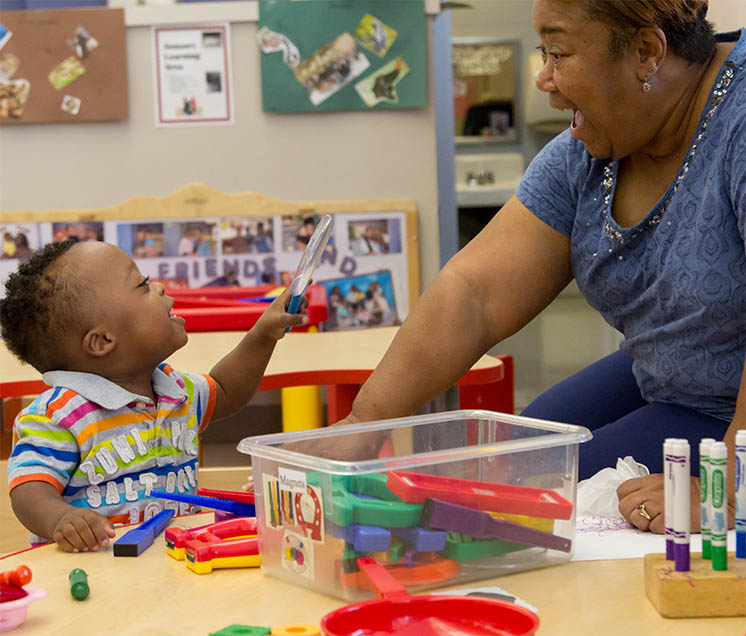An observation is like a photograph—it captures a moment in time. As an observer, you are like the photographer, focusing on some things, ignoring others. Like the photographer, you bring your own ideas, preferences, and perceptions to the act of observing.
 It takes practice to become a good observer. For education staff and families, an important aspect of being a good observer involves knowing that what they notice and how they interpret their observations about infants and toddlers may be influenced by many things. Culture, temperament, the presence of a delay or disability, personal experiences and relationships, professional knowledge, and even community values and messages in the media affect how staff and families see and experience children.
It takes practice to become a good observer. For education staff and families, an important aspect of being a good observer involves knowing that what they notice and how they interpret their observations about infants and toddlers may be influenced by many things. Culture, temperament, the presence of a delay or disability, personal experiences and relationships, professional knowledge, and even community values and messages in the media affect how staff and families see and experience children.
These lenses through which staff and families observe and interpret are at work even though they may not always be conscious of them. For example, two adults (e.g., home visitor-parent; teacher-teacher) may both see an infant fuss but interpret differently what the fussy behavior means—and respond differently. Observing young children involves self-awareness, and this awareness evolves over time. So, it is important to help staff and families identify various influences and begin to recognize when these influences may be interfering with seeing a child for who he or she really is. Here are some things to consider:
- Every person comes from a culture, and every family's culture is unique. Culture—attitudes, beliefs, expectations about people and events—shapes us as humans and as early childhood professionals. For example, some cultures consider it respectful to look someone in the eye when speaking or being spoken to. Other cultures consider it respectful to look down when someone is speaking. A home visitor whose culture values looking someone in the eye when speaking may think that a child or family member whose culture values eyes down when someone speaks is ignoring her or being disrespectful.
- Traits such as temperament (e.g., being cautious, outgoing, or sensitive; having a need for order), personal interests and preferences, and feelings (e.g., what makes us feel excited, apprehensive, uncomfortable) also affect how adults see and relate to children. These traits may help them feel closer to children with similar traits. They may pay more attention to children with similar traits and observe them more frequently than other children. These traits may also drive adults away from children whose traits are different. Staff may pay them less attention or interpret their behaviors more negatively. For example, a teacher who has a high tolerance for bright lights, environmental noise, and a lot of "stuff" on shelves and walls may have a hard time figuring out that an infant who cries frequently may be overstimulated by those same things.
- Staff gain professional knowledge and grounding for understanding and responding to infants and toddlers from coursework, workshops, preservice and in-service training, coaching, mentoring, and daily practice in center-based classrooms, family child care homes, and home visits. They should feel confident about bringing this knowledge and experience to observing children and interpreting their actions. However, part of being an early childhood professional is maintaining an open mind. Professional knowledge and experience should not be a barrier to really seeing and understanding a child. An early childhood professional knows there is always more to learn about observing and responding to children.
To support education staff and families:
- Share Multicultural Principles for Early Childhood Leaders during pre- and in-service trainings and staff meetings. Use the reflection questions and activities that accompany each principle to offer opportunities for staff to identify and address their own cultural beliefs and practices as well as those of the children and families. Consider sharing the principles at parent meetings or trainings and adapting reflection questions and activities so they are appropriate and relevant for families.
- Use resources such as the training guide Including Infants and Toddlers with Disabilities to help staff look at beliefs and attitudes that may influence how they see and relate to children with disabilities in their program.
- Use reflective supervision to continue one-on-one conversations with staff about how their beliefs, preferences, and professional experience inform how they observe and see the infants, toddlers, and families with whom they work. Provide guidance, as needed, on how staff can balance competing perspectives, as well as talk with families and each other, to understand differing views and work together in the best interests of each infant and toddler.
Read more:
Resource Type: Article
National Centers: Early Childhood Development, Teaching and Learning
Last Updated: February 6, 2024
